Intercalation Polymerization Approach for Preparing Graphene/Polymer Composites
Abstract
1. Introduction
2. Intercalation of Graphite
2.1. Traditional Graphite Intercalated Compounds (GIC)
2.2. Organic Intercalating Compounds
2.2.1. Electrochemical Methods
2.2.2. Cation Exchange Methods
2.2.3. Chemical Methods
3. Polymerization in the Interlayers of Graphite
3.1. Intercalation Polymerization Methods
3.1.1. Polymerization Initiated by Pre-Intercalated Compounds
3.1.2. In Situ Intercalation Polymerization
3.2. Characterization of Intercalation Polymerization
3.3. Influence Factors on Intercalation Polymerization
3.3.1. Source of Graphene
3.3.2. Intercalant Species
3.3.3. Process Parameters of Intercalation Polymerization
4. Application of Graphene/Polymer Composites
4.1. Electrical Conductivity
4.2. Electromagnetic Wave Absorption
4.3. Mechanical Properties
4.4. Thermal Conductivity
4.5. Other Applications
5. Conclusions and Outlook
Acknowledgments
Author Contributions
Conflicts of Interest
Abbreviations
| CVD | Chemical vapor deposition |
| NG | Natural graphite |
| GO | Graphene oxide |
| GtO | Graphite oxide |
| GIC | Graphite intercalated compounds |
| Pyr14TFSI | N-butyl-N-methylpyrrolidinium bis-(trifluoromethanesulfonyl)imide |
| PC | Propylene carbonate |
| DMSO | Dimethyl sulfoxide |
| DMF | Dimethylformamide |
| Pyr14+ | N-butyl-N-methylpyrrolidinium cation |
| LiTFSI | Lithium bis(trifluoromethanesulfonyl)imide |
| TFSI− | Bis(trifluoromethanesulfonyl)imide anion |
| TBA+ | Tetrabutylammonium cations |
| 1,2-DAP | 1,2-diaminopropane |
| XRD | X-ray diffraction |
| ANi+ | Aniline cation |
| CL+ | Caprolactam onium ion |
| EOG | Edge-selectively oxidized graphite |
| C14N+ | Tetradecyl-ammonium cation |
| TAA+ | Tetraalkylammonium ions |
| PVA | Poly(vinyl alcohol) |
| PDDA | Poly(diallyldimethylammonium chloride) |
| PVAc | Poly(vinyl acetate) |
| EG | Expanded graphite |
| ANi | Aniline |
| KC24 | Stage 2 potassium intercalated graphite |
| KC8 | Stage I potassium intercalated graphite |
| GNRs | Graphene nanoribbons |
| MWCNTs | Multiwalled carbon nanotubes |
| PANi | Polyaniline |
| PPy | Polypyrrole |
| PA-6 | Polyamide-6 |
| CEG | Chemical expanded graphite |
| PMMA | Polymethyl methacrylate |
| SEM | Scanning electron microscope |
| TEM | Transmission electron microscope |
| AFM | Atomic force microscope |
| FTIR | Fourier transform infrared |
| XPS | X-ray photoelectron spectroscopy |
| DSC | Differential scanning calorimetry |
| POM | Polarized optical microscopy |
| rGO | Reduced graphene oxide |
| PEO | Polyethylene oxide |
| PBT | Poly(butylene terephthalate) |
| PET | Poly(ethylene terephthalate) |
| PI | Polyimide |
| EM | Electromagnetic waves |
| RL | Refection loss |
| NBR | Nitrile butadiene rubber |
| TPU | Thermoplastic polyurethane |
| TC | Thermal conductivity |
| PS | Polystyrene |
| PP | Polypropylene |
| PLA | Poly(lactic acid) |
References
- Novoselov, K.S.; Geim, A.K.; Morozov, S.V.; Jiang, D.; Zhang, Y.; Dubonos, S.V.; Grigorieva, I.V.; Firsov, A.A. Electric field effect in atomically thin carbon films. Science 2004, 306, 666–669. [Google Scholar] [CrossRef] [PubMed]
- Xu, Z.; Gao, C. Graphene chiral liquid crystals and macroscopic assembled fibres. Nat. Commun. 2011, 2, 571. [Google Scholar] [CrossRef] [PubMed]
- Raccichini, R.; Varzi, A.; Passerini, S.; Scrosati, B. The role of graphene for electrochemical energy storage. Nat. Mater. 2015, 14, 271–279. [Google Scholar] [CrossRef] [PubMed]
- Peng, L.; Xu, Z.; Liu, Z.; Guo, Y.; Li, P.; Gao, C. Ultrahigh thermal conductive yet superflexible graphene films. Adv. Mater. 2017, 29, 1700589. [Google Scholar] [CrossRef] [PubMed]
- Xin, G.; Yao, T.; Sun, H.; Scott, S.M.; Shao, D.; Wang, G.; Lian, J. Highly thermally conductive and mechanically strong graphene fibers. Science 2015, 349, 1083–1087. [Google Scholar] [CrossRef] [PubMed]
- Cairns, D.R.; Witte, R.P.; Sparacin, D.K.; Sachsman, S.M.; Paine, D.C.; Crawford, G.P.; Newton, R.R. Strain-dependent electrical resistance of tin-doped indium oxide on polymer substrates. Appl. Phys. Lett. 2000, 76, 1425–1427. [Google Scholar] [CrossRef]
- Jang, H.; Park, Y.J.; Chen, X.; Das, T.; Kim, M.S.; Ahn, J.H. Graphene-based flexible and stretchable electronics. Adv. Mater. 2016, 28, 4184–4202. [Google Scholar] [CrossRef] [PubMed]
- Cao, G. Atomistic studies of mechanical properties of graphene. Polymers 2014, 6, 2404–2432. [Google Scholar] [CrossRef]
- Nan, L.; Chortos, A.; Lei, T.; Jin, L.; Kim, T.R.; Bae, W.G.; Zhu, C.; Wang, S.; Pfattner, R.; Chen, X. Ultratransparent and stretchable graphene electrodes. Sci. Adv. 2017, 3, e1700159. [Google Scholar]
- Feng, C.; Wang, Y.; Kitipornchai, S.; Yang, J. Effects of reorientation of graphene platelets (GPLs) on Young’s modulus of polymer nanocomposites under uni-axial stretching. Polymers 2017, 9, 532. [Google Scholar] [CrossRef]
- Kim, D.S.; Dhand, V.; Rhee, K.Y.; Park, S.J. Study on the effect of silanization and improvement in the tensile behavior of graphene-chitosan-composite. Polymers 2015, 7, 527–551. [Google Scholar] [CrossRef]
- Skountzos, E.N.; Anastassiou, A.; Mavrantzas, V.G.; Theodorou, D.N. Determination of the mechanical properties of a poly(methyl methacrylate) nanocomposite with functionalized graphene sheets through detailed atomistic simulations. Macromolecules 2014, 47, 8072–8088. [Google Scholar] [CrossRef]
- Tang, Y.; Hu, X.; Liu, D.; Guo, D.; Zhang, J. Effect of microwave treatment of graphite on the electrical conductivity and electrochemical properties of polyaniline/graphene oxide composites. Polymers 2016, 8, 399. [Google Scholar] [CrossRef]
- Wang, Z.; Shen, X.; Han, N.M.; Liu, X.; Wu, Y.; Ye, W.; Kim, J.-K. Ultralow electrical percolation in graphene aerogel/epoxy composites. Chem. Mater. 2016, 28, 6731–6741. [Google Scholar] [CrossRef]
- Beckert, F.; Held, A.; Meier, J.; Mülhaupt, R.; Friedrich, C. Shear- and temperature-induced graphene network evolution in graphene/polystyrene nanocomposites and its influence on rheological, electrical, and morphological properties. Macromolecules 2014, 47, 8784–8794. [Google Scholar] [CrossRef]
- Li, A.; Zhang, C.; Zhang, Y.F.; Li, A.; Zhang, C.; Zhang, Y.F. Thermal conductivity of graphene-polymer composites: Mechanisms, properties, and applications. Polymers 2017, 9, 437. [Google Scholar]
- Hong, H.; Kim, J.; Kim, T.I. Effective assembly of nano-ceramic materials for high and anisotropic thermal conductivity in a polymer composite. Polymers 2017, 9, 413. [Google Scholar] [CrossRef]
- Meng, F.; Huang, F.; Guo, Y.; Chen, J.; Chen, X.; Hui, D.; He, P.; Zhou, X.; Zhou, Z. In situ intercalation polymerization approach to polyamide-6/graphite nanoflakes for enhanced thermal conductivity. Compos. Part B Eng. 2017, 117, 165–173. [Google Scholar] [CrossRef]
- Yoonessi, M.; Shi, Y.; Scheiman, D.A.; Lebron-Colon, M.; Tigelaar, D.M.; Weiss, R.A.; Meador, M.A. Graphene polyimide nanocomposites; thermal, mechanical, and high-temperature shape memory effects. ACS Nano 2012, 6, 7644–7655. [Google Scholar] [CrossRef] [PubMed]
- Li, C.; Qiu, L.; Zhang, B.; Li, D.; Liu, C.Y. Robust vacuum-/air-dried graphene aerogels and fast recoverable shape-memory hybrid foams. Adv. Mater. 2016, 28, 1510–1516. [Google Scholar] [CrossRef] [PubMed]
- Wang, J.; Sun, L.; Zou, M.; Gao, W.; Liu, C.; Shang, L.; Gu, Z.; Zhao, Y. Bioinspired shape-memory graphene film with tunable wettability. Sci. Adv. 2017, 3, e1700004. [Google Scholar] [CrossRef] [PubMed]
- Chen, H.; Gao, Q.; Li, J.; Lin, J.M. Graphene materials-based chemiluminescence for sensing. J. Photochem. Photobiol. C 2016, 27, 54–71. [Google Scholar] [CrossRef]
- Luo, J.; Xu, Y.; Yao, W.; Jiang, C.; Xu, J. Synthesis and microwave absorption properties of reduced graphene oxide-magnetic porous nanospheres-polyaniline composites. Compos. Sci. Technol. 2015, 117, 315–321. [Google Scholar] [CrossRef]
- Wang, L.; Huang, Y.; Li, C.; Chen, J.; Sun, X. Hierarchical composites of polyaniline nanorod arrays covalently-grafted on the surfaces of graphene@Fe3O4@C with high microwave absorption performance. Compos. Sci. Technol. 2015, 108, 1–8. [Google Scholar] [CrossRef]
- Yan, D.X.; Pang, H.; Li, B.; Vajtai, R.; Xu, L.; Ren, P.G.; Wang, J.H.; Li, Z.M. Structured reduced graphene oxide/polymer composites for ultra-efficient electromagnetic interference shielding. Adv. Funct. Mater. 2015, 25, 559–566. [Google Scholar] [CrossRef]
- Marra, F.; D’Aloia, A.G.; Tamburrano, A.; Ochando, I.M.; Bellis, G.D.; Ellis, G.; Sarto, M.S. Electromagnetic and dynamic mechanical properties of epoxy and vinylester-based composites filled with graphene nanoplatelets. Polymers 2016, 8, 272. [Google Scholar] [CrossRef]
- Shen, B.; Zhai, W.; Cao, C.; Lu, D.; Jing, W.; Zheng, W. Melt blending in situ enhances the interaction between polystyrene and graphene through π–π stacking. ACS Appl. Mater. Interfaces 2011, 3, 3103–3109. [Google Scholar] [CrossRef] [PubMed]
- Liu, C.; Wong, H.; Yeung, K.; Tjong, S. Novel electrospun polylactic acid nanocomposite fiber mats with hybrid graphene oxide and nanohydroxyapatite reinforcements having enhanced biocompatibility. Polymers 2016, 8, 287. [Google Scholar] [CrossRef]
- Kim, H.; Kobayashi, S.; AbdurRahim, M.A.; Zhang, M.J.; Khusainova, A.; Hillmyer, M.A.; Abdala, A.A.; Macosko, C.W. Graphene/polyethylene nanocomposites: Effect of polyethylene functionalization and blending methods. Polymer 2011, 52, 1837–1846. [Google Scholar] [CrossRef]
- Araby, S.; Meng, Q.; Zhang, L.; Kang, H.; Majewski, P.; Tang, Y.; Ma, J. Electrically and thermally conductive elastomer/graphene nanocomposites by solution mixing. Polymer 2014, 55, 201–210. [Google Scholar] [CrossRef]
- Gaska, K.; Xu, X.; Gubanski, S.; Kádár, R. Electrical, mechanical, and thermal properties of LDPE graphene nanoplatelets composites produced by means of melt extrusion process. Polymers 2017, 9, 11. [Google Scholar] [CrossRef]
- Wang, X.; Hu, Y.; Song, L.; Yang, H.; Xing, W.; Lu, H. In situ polymerization of graphene nanosheets and polyurethane with enhanced mechanical and thermal properties. J. Mater. Chem. 2011, 21, 4222–4227. [Google Scholar] [CrossRef]
- Xu, Z.; Gao, C. In situ polymerization approach to graphene-reinforced nylon-6 composites. Macromolecules 2010, 43, 6716–6723. [Google Scholar] [CrossRef]
- Liu, S.; Wang, L.; Tian, J.; Luo, Y.; Zhang, X.; Sun, X. Aniline as a dispersing and stabilizing agent for reduced graphene oxide and its subsequent decoration with Ag nanoparticles for enzymeless hydrogen peroxide detection. J. Colloid Interface Sci. 2011, 363, 615–619. [Google Scholar] [CrossRef] [PubMed]
- Das, S.; Wajid, A.S.; Shelburne, J.L.; Liao, Y.-C.; Green, M.J. Localized in situ polymerization on graphene surfaces for stabilized graphene dispersions. ACS Appl. Mater. Interfaces 2011, 3, 1844–1851. [Google Scholar] [CrossRef] [PubMed]
- Wang, J.-Y.; Yang, S.-Y.; Huang, Y.-L.; Tien, H.-W.; Chin, W.-K.; Ma, C.-C.M. Preparation and properties of graphene oxide/polyimide composite films with low dielectric constant and ultrahigh strength via in situ polymerization. J. Mater. Chem. 2011, 21, 13569–13575. [Google Scholar] [CrossRef]
- Chen, Y.; Sun, J.; Gao, J.; Du, F.; Han, Q.; Nie, Y.; Chen, Z.; Bachmatiuk, A.; Priydarshi, M.K.; Ma, D. Growing uniform graphene disks and films on molten glass for heating devices and cell culture. Adv. Mater. 2015, 27, 7839–7846. [Google Scholar] [CrossRef] [PubMed]
- Guo, W.; Jing, F.; Xiao, J.; Zhou, C.; Lin, Y.; Wang, S. Oxidative-etching-assisted synthesis of centimeter-sized single-crystalline graphene. Adv. Mater. 2016, 28, 3152–3158. [Google Scholar] [CrossRef] [PubMed]
- Yang, W.; Chen, G.; Shi, Z.; Liu, C.-C.; Zhang, L.; Xie, G.; Cheng, M.; Wang, D.; Yang, R.; Shi, D. Epitaxial growth of single-domain graphene on hexagonal boron nitride. Nat. Mater. 2013, 12, 792–797. [Google Scholar] [CrossRef] [PubMed]
- Gu, W.; Zhang, W.; Li, X.; Zhu, H.; Wei, J.; Li, Z.; Shu, Q.; Wang, C.; Wang, K.; Shen, W. Graphene sheets from worm-like exfoliated graphite. J. Mater. Chem. 2009, 19, 3367–3369. [Google Scholar] [CrossRef]
- Qian, W.; Hao, R.; Hou, Y.; Tian, Y.; Shen, C.; Gao, H.; Liang, X. Solvothermal-assisted exfoliation process to produce graphene with high yield and high quality. Nano Res. 2009, 2, 706–712. [Google Scholar] [CrossRef]
- Ciesielski, A.; Samorì, P. Graphene via sonication assisted liquid-phase exfoliation. Chem. Soc. Rev. 2014, 43, 381–398. [Google Scholar] [CrossRef] [PubMed]
- Geng, X.; Guo, Y.; Li, D.; Li, W.; Zhu, C.; Wei, X.; Chen, M.; Gao, S.; Qiu, S.; Gong, Y. Interlayer catalytic exfoliation realizing scalable production of large-size pristine few-layer graphene. Sci. Rep. 2013, 3, 1134. [Google Scholar] [CrossRef] [PubMed]
- Peng, L.; Xu, Z.; Liu, Z.; Wei, Y.; Sun, H.; Li, Z.; Zhao, X.; Gao, C. An iron-based green approach to 1-h production of single-layer graphene oxide. Nat. Commun. 2015, 6, 5716. [Google Scholar] [CrossRef] [PubMed]
- Georgakilas, V.; Tiwari, J.N.; Kemp, K.C.; Perman, J.A.; Bourlinos, A.B.; Kim, K.S.; Zboril, R. Noncovalent functionalization of graphene and graphene oxide for energy materials, biosensing, catalytic, and biomedical applications. Chem. Rev. 2016, 116, 5464–5519. [Google Scholar] [CrossRef] [PubMed]
- Renteria, J.D.; Ramirez, S.; Malekpour, H.; Alonso, B.; Centeno, A.; Zurutuza, A.; Cocemasov, A.I.; Nika, D.L.; Balandin, A.A. Strongly anisotropic thermal conductivity of free-standing reduced graphene oxide films annealed at high temperature. Adv. Funct. Mater. 2015, 25, 4664–4672. [Google Scholar] [CrossRef]
- Matsumoto, R.; Arakawa, M.; Yoshida, H.; Akuzawa, N. Alkali-metal-graphite intercalation compounds prepared from flexible graphite sheets exhibiting high air stability and electrical conductivity. Synth. Met. 2012, 162, 2149–2154. [Google Scholar] [CrossRef]
- Jones, J.E.; Cheshire, M.C.; Casadonte, D.J.J.; Phifer, C.C. Facile sonochemical synthesis of graphite intercalation compounds. Org. Lett. 2004, 6, 1915–1917. [Google Scholar] [CrossRef] [PubMed]
- Dimiev, A.M.; Ceriotti, G.; Metzger, A.; Kim, N.D.; Tour, J.M. Chemical mass production of graphene nanoplatelets in ∼100% yield. ACS Nano 2015, 10, 274–279. [Google Scholar] [CrossRef] [PubMed]
- Zhao, W.; Tan, P.H.; Liu, J.; Ferrari, A.C. Intercalation of few-layer graphite flakes with FeCl3: Raman determination of fermi level, layer by layer decoupling, and stability. J. Am. Chem. Soc. 2011, 133, 5941–5946. [Google Scholar] [CrossRef] [PubMed]
- Khrapach, I.; Withers, F.; Bointon, T.H.; Polyushkin, D.K.; Barnes, W.L.; Russo, S.; Craciun, M.F. Novel highly conductive and transparent graphene-based conductors. Adv. Mater. 2012, 24, 2844–2849. [Google Scholar] [CrossRef] [PubMed]
- Vallés, C.; Drummond, C.; Saadaoui, H.; Furtado, C.A.; He, M.; Roubeau, O.; Ortolani, L.; Monthioux, M.; Pénicaud, A. Solutions of negatively charged graphene sheets and ribbons. J. Am. Chem. Soc. 2008, 130, 15802–15804. [Google Scholar] [CrossRef] [PubMed]
- Chen, X.; Meng, F.; Zhou, Z.; Tian, X.; Shan, L.; Zhu, S.; Xu, X.; Jiang, M.; Wang, L.; Hui, D. One-step synthesis of graphene/polyaniline hybrids by in situ intercalation polymerization and their electromagnetic properties. Nanoscale 2014, 6, 8140–8148. [Google Scholar] [CrossRef] [PubMed]
- Bissessur, R.; Scully, S.F. Intercalation of solid polymer electrolytes into graphite oxide. Solid State Ion. 2007, 178, 877–882. [Google Scholar] [CrossRef]
- Dresselhaus, M.S.; Dresselhaus, G. Intercalation compounds of graphite. Adv. Phys. 2002, 51, 1–186. [Google Scholar] [CrossRef]
- Srinivas, G.; Lovell, A.; Howard, C.A.; Skipper, N.T.; Ellerby, M.; Bennington, S.M. Structure and phase stability of hydrogenated first-stage alkali- and alkaline-earth metal–graphite intercalation compounds. Synth. Met. 2010, 160, 1631–1635. [Google Scholar] [CrossRef]
- Höhne, M.; Wang, Y.; Stumpp, E.; Hummel, H.-J. New ternary alkaline earth metal-ammonia compounds. Synth. Met. 1989, 34, 41–46. [Google Scholar] [CrossRef]
- Cahen, S.; Vangelisti, R. Synthesis, structure and magnetic properties of lanthanide trichlorides-GIC: Stage2 DyCl3–GIC. J. Phys. Chem. Solids 2006, 67, 1223–1227. [Google Scholar] [CrossRef]
- Hagiwara, R.; Ito, M.; Ito, Y. Graphite intercalation compounds of lanthanide metals prepared in molten chlorides. Carbon 1996, 34, 1591–1593. [Google Scholar] [CrossRef]
- Emery, N.; Hérold, C.; Lagrange, P. The synthesis of binary metal-graphite intercalation compounds using molten lithium alloys. Carbon 2008, 46, 72–75. [Google Scholar] [CrossRef]
- Rousseau, B.; Estrade-Szwarckopf, H. X-ray and UV photoelectron spectroscopy study of Na–halogen–graphite intercalation compounds. Comparison between donor-and acceptor-graphite compounds. Solid State Commun. 2003, 126, 583–587. [Google Scholar] [CrossRef]
- Wang, F.; Yi, J.; Wang, Y.; Wang, C.; Wang, J.; Xia, Y. Graphite intercalation compounds (GICs): A new type of promising anode material for lithium-ion batteries. Adv. Energy Mater. 2014, 4, 5866–5874. [Google Scholar] [CrossRef]
- Stumpp, E.; Hummel, H.-J.; Ehrhardt, C. Thermogravimetric study of gold (III) bromide graphite. Synth. Met. 1988, 23, 441–446. [Google Scholar] [CrossRef]
- Noel, M.; Santhanam, R. Electrochemistry of graphite intercalation compounds. J. Power Sources 1998, 72, 53–65. [Google Scholar] [CrossRef]
- Sorokina, N.; Shornikova, O.; Avdeev, V. Stability limits of graphite intercalation compounds in the systems graphite-HNO3 (H2SO4)-H2O-KMnO4. Inorg. Mater. 2007, 43, 822–826. [Google Scholar] [CrossRef]
- Savoskin, M.V.; Yaroshenko, A.P.; Whyman, G.; Mestechkin, M.M.; Mysyk, R.D.; Mochalin, V. Theoretical study of stability of graphite intercalation compounds with brønsted acids. Carbon 2003, 41, 2757–2760. [Google Scholar] [CrossRef]
- Liu, Y.; Xu, Z.; Zhan, J.; Li, P.; Gao, C. Superb electrically conductive graphene fibers via doping strategy. Adv. Mater. 2016, 28, 7941–7947. [Google Scholar] [CrossRef] [PubMed]
- Han, W.-P.; Li, Q.-Q.; Lu, Y.; Yan, X.; Zhao, H.; Long, Y.-Z. Optical contrast spectra studies for determining thickness of stage-1 graphene-FeCl3 intercalation compounds. AIP Adv. 2016, 6, 075219. [Google Scholar] [CrossRef]
- Bointon, T.H.; Khrapach, I.; Yakimova, R.; Shytov, A.V.; Craciun, M.F.; Russo, S. Approaching magnetic ordering in graphene materials by FeCl3 intercalation. Nano Lett. 2014, 14, 1751–1755. [Google Scholar] [CrossRef] [PubMed]
- Bepete, G.; Hof, F.; Huang, K.; Kampioti, K.; Anglaret, E.; Drummond, C.; Pénicaud, A. “Eau de graphene” from a KC8 graphite intercalation compound prepared by a simple mixing of graphite and molten potassium. Phys. Status Solidi 2016, 10, 895–899. [Google Scholar]
- Maluangnont, T.; Gotoh, K.; Fujiwara, K.; Lerner, M.M. Cation-directed orientation of amines in ternary graphite intercalation compounds. Carbon 2011, 49, 1040–1042. [Google Scholar] [CrossRef]
- Wen, Y.; He, K.; Zhu, Y.; Han, F.; Xu, Y.; Matsuda, I.; Ishii, Y.; Cumings, J.; Wang, C. Expanded graphite as superior anode for sodium-ion batteries. Nat. Commun. 2014, 5, 4033. [Google Scholar] [CrossRef] [PubMed]
- Yang, S.; Brüller, S.; Wu, Z.S.; Liu, Z.; Parvez, K.; Dong, R.; Richard, F.; Samori, P.; Feng, X.; Müllen, K. Organic radical-assisted electrochemical exfoliation for the scalable production of high-quality graphene. J. Am. Chem. Soc. 2015, 137, 13927–13932. [Google Scholar] [CrossRef] [PubMed]
- Parvez, K.; Wu, Z.S.; Li, R.; Liu, X.; Graf, R.; Feng, X.; Müllen, K. Exfoliation of graphite into graphene in aqueous solutions of inorganic salts. J. Am. Chem. Soc. 2014, 136, 6083–6091. [Google Scholar] [CrossRef] [PubMed]
- Wang, D.-Y.; Wei, C.-Y.; Lin, M.-C.; Pan, C.-J.; Chou, H.-L.; Chen, H.-A.; Gong, M.; Wu, Y.; Yuan, C.; Angell, M. Advanced rechargeable aluminium ion battery with a high-quality natural graphite cathode. Nat. Commun. 2017, 8, 14283. [Google Scholar] [CrossRef] [PubMed]
- Rodríguez-Pérez, I.A.; Ji, X. Anion hosting cathodes in dual-ion batteries. ACS Energy Lett. 2017, 2, 1762–1770. [Google Scholar] [CrossRef]
- Xu, J.; Dou, Y.; Wei, Z.; Ma, J.; Deng, Y.; Li, Y.; Liu, H.; Dou, S. Recent progress in graphite intercalation compounds for rechargeable metal (Li, Na, K, Al)-ion batteries. Adv. Sci. 2017, 4, 1700146. [Google Scholar] [CrossRef] [PubMed]
- Wang, Y.; Liu, B.; Li, Q.; Cartmell, S.; Ferrara, S.; Deng, Z.D.; Xiao, J. Lithium and lithium ion batteries for applications in microelectronic devices: A review. J. Power Sources 2015, 286, 330–345. [Google Scholar] [CrossRef]
- Li, Z.; Huang, J.; Liaw, B.Y.; Metzler, V.; Zhang, J. A review of lithium deposition in lithium-ion and lithium metal secondary batteries. J. Power Sources 2014, 254, 168–182. [Google Scholar] [CrossRef]
- Lin, M.-C.; Gong, M.; Lu, B.; Wu, Y.; Wang, D.-Y.; Guan, M.; Angell, M.; Chen, C.; Yang, J.; Hwang, B.-J. An ultrafast rechargeable aluminium-ion battery. Nature 2015, 520, 324–328. [Google Scholar] [CrossRef] [PubMed]
- Bonaccorso, F.; Lombardo, A.; Hasan, T.; Sun, Z.; Colombo, L.; Ferrari, A.C. Production and processing of graphene and 2d crystals. Mater. Today 2012, 15, 564–589. [Google Scholar] [CrossRef]
- Rothermel, S.; Meister, P.; Schmuelling, G.; Fromm, O.; Meyer, H.; Nowak, S.; Winter, M.; Placke, T. Dual-graphite cells based on the reversible intercalation of bis(trifluoromethanesulfonyl)imide anions from an ionic liquid electrolyte. Energy Environ. Sci. 2014, 7, 3412–3423. [Google Scholar] [CrossRef]
- Placke, T.; Fromm, O.; Lux, S.F.; Bieker, P.; Rothermel, S.; Meyer, H.W.; Passerini, S.; Winter, M. Reversible intercalation of bis(trifluoromethanesulfonyl)imide anions from an ionic liquid electrolyte into graphite for high performance dual-ion cells. J. Electrochem. Soc. 2012, 159, A1755–A1765. [Google Scholar] [CrossRef]
- Li, B.; Xu, M.; Li, T.; Li, W.; Hu, S. Prop-1-ene-1,3-sultone as SEI formation additive in propylene carbonate-based electrolyte for lithium ion batteries. Electrochem. Commun. 2012, 17, 92–95. [Google Scholar] [CrossRef]
- Meister, P.; Siozios, V.; Reiter, J.; Klamor, S.; Rothermel, S.; Fromm, O.; Meyer, H.W.; Winter, M.; Placke, T. Dual-ion cells based on the electrochemical intercalation of asymmetric fluorosulfonyl-(trifluoromethanesulfonyl) imide anions into graphite. Electrochim. Acta 2014, 130, 625–633. [Google Scholar] [CrossRef]
- Moon, H.; Tatara, R.; Mandai, T.; Ueno, K.; Yoshida, K.; Tachikawa, N.; Yasuda, T.; Dokko, K.; Watanabe, M. Mechanism of Li ion desolvation at the interface of graphite electrode and glyme–Li salt solvate ionic liquids. J. Phys. Chem. C 2014, 118, 20246–20256. [Google Scholar] [CrossRef]
- Takeuchi, S.; Fukutsuka, T.; Miyazaki, K.; Abe, T. Electrochemical preparation of a lithium–graphite-intercalation compound in a dimethyl sulfoxide-based electrolyte containing calcium ions. Carbon 2013, 57, 232–238. [Google Scholar] [CrossRef]
- Tasaki, K. Density functional theory study on structural and energetic characteristics of graphite intercalation compounds. J. Phys. Chem. C 2015, 118, 1443–1450. [Google Scholar] [CrossRef]
- Billaud, D.; Pron, A.; Vogel, F.L.; Hérold, A. Intercalation of pyrographite by NO2+ and NO+ salts. Mater. Res. Bull. 1980, 15, 1627–1634. [Google Scholar] [CrossRef]
- Jobert, A.; Touzain, P.; Bonnetain, L. Insertion des ions PF6−, AsF6− et SbF6− dans le graphite par methode electrochimique. Caracterisation des produits obtenus. Carbon 1981, 19, 193–198. [Google Scholar] [CrossRef]
- Xia, Z.Y.; Giambastiani, G.; Christodoulou, C.; Nardi, M.V.; Koch, N.; Treossi, E.; Bellani, V.; Pezzini, S.; Corticelli, F.; Morandi, V. Synergic exfoliation of graphene with organic molecules and inorganic ions for the electrochemical production of flexible electrodes. Chempluschem 2014, 79, 439–446. [Google Scholar] [CrossRef]
- Sirisaksoontorn, W.; Lerner, M.M. Preparation of a homologous series of tetraalkylammonium graphite intercalation compounds. Inorg. Chem. 2013, 52, 7139–7144. [Google Scholar] [CrossRef] [PubMed]
- Zhang, H.; Lerner, M.M. Preparation of graphite intercalation compounds containing oligo and polyethers. Nanoscale 2016, 8, 4608–4612. [Google Scholar] [CrossRef] [PubMed]
- Do Nascimento, G.M.; Constantino, V.R.L.; Landers, R.; Temperini, M.L.A. Aniline polymerization into montmorillonite clay: A spectroscopic investigation of the intercalated conducting polymer. Mol. Microbiol. 2004, 52, 751–761. [Google Scholar] [CrossRef]
- Sirisaksoontorn, W.; Adenuga, A.A.; Remcho, V.T.; Lerner, M.M. Preparation and characterization of a tetrabutylammonium graphite intercalation compound. J. Am. Chem. Soc. 2011, 133, 12436–12438. [Google Scholar] [CrossRef] [PubMed]
- Zhong, Y.L.; Swager, T.M. Enhanced electrochemical expansion of graphite for in situ electrochemical functionalization. J. Am. Chem. Soc. 2012, 134, 17896. [Google Scholar] [CrossRef] [PubMed]
- Zhang, H.; Lerner, M.M. Preparation of graphite intercalation compounds containing crown ethers. Inorg. Chem. 2016, 55, 8281–8284. [Google Scholar] [CrossRef] [PubMed]
- Xu, J.; Dang, D.K.; Tran, V.T.; Liu, X.; Chung, J.S.; Hur, S.H.; Choi, W.M.; Kim, E.J.; Kohl, P.A. Liquid-phase exfoliation of graphene in organic solvents with addition of naphthalene. J. Colloid Interface Sci. 2014, 418, 37–42. [Google Scholar] [CrossRef] [PubMed]
- Wei, L.; Wu, F.; Shi, D.; Hu, C.; Li, X.; Yuan, W.; Wang, J.; Zhao, J.; Geng, H.; Wei, H. Spontaneous intercalation of long-chain alkyl ammonium into edge-selectively oxidized graphite to efficiently produce high-quality graphene. Sci. Rep. 2013, 3, 2636. [Google Scholar] [CrossRef] [PubMed]
- Liu, Z.H.; Wang, Z.M.; Yang, X.; Ooi, K. Intercalation of organic ammonium ions into layered graphite oxide. Langmuir 2002, 18, 4926–4932. [Google Scholar] [CrossRef]
- Matsuo, Y.; Tahara, K.; Sugie, Y. Structure and thermal properties of poly(ethylene oxide)-intercalated graphite oxide. Carbon 1997, 35, 113–120. [Google Scholar] [CrossRef]
- Matsuo, Y.; Hatase, K.; Sugie, Y. Preparation and characterization of poly(vinyl alcohol)- and Cu(OH)2-poly(vinyl alcohol)-intercalated graphite oxides. Chem. Mater. 1998, 10, 2266–2269. [Google Scholar] [CrossRef]
- Kotov, N.A.; Dékány, I.; Fendler, J.H. Ultrathin graphite oxide-polyelectrolyte composites prepared by self-assembly: Transition between conductive and non-conductive states. Adv. Mater. 1996, 8, 637–641. [Google Scholar] [CrossRef]
- Liu, P.; Gong, K.; Xiao, P.; Xiao, M. Preparation and characterization of poly(vinyl acetate)-intercalated graphite oxide nanocomposite. J. Mater. Chem. 2000, 10, 933–935. [Google Scholar] [CrossRef]
- Kim, H.; Hahn, H.T.; Viculis, L.M.; Gilje, S.; Kaner, R.B. Electrical conductivity of graphite/polystyrene composites made from potassium intercalated graphite. Carbon 2007, 45, 1578–1582. [Google Scholar] [CrossRef]
- Nadiv, R.; Shtein, M.; Buzaglo, M.; Peretz-Damari, S.; Kovalchuk, A.; Wang, T.; Tour, J.M.; Regev, O. Graphene nanoribbon—Polymer composites: The critical role of edge functionalization. Carbon 2016, 99, 444–450. [Google Scholar] [CrossRef]
- Ma, J.; Li, Y.; Yin, X.; Xu, Y.; Yue, J.; Bao, J.; Zhou, T. Poly(vinyl alcohol)/graphene oxide nanocomposites prepared by in situ polymerization with enhanced mechanical properties and water vapor barrier properties. RSC Adv. 2016, 6, 49448–49458. [Google Scholar] [CrossRef]
- Shioyama, H.; Tatsumi, K.; Iwashita, N.; Fujita, K.; Sawada, Y. On the interaction between the potassium—GIC and unsaturated hydrocarbons. Synth. Met. 1998, 96, 229–233. [Google Scholar] [CrossRef]
- Shioyama, H. On the interaction between alkali metal-GICs and unsaturated hydrocarbons. Mol. Cryst. Liq. Cryst. 2000, 340, 101–106. [Google Scholar] [CrossRef]
- Lu, W.; Ruan, G.; Genorio, B.; Zhu, Y.; Novosel, B.; Peng, Z.; Tour, J.M. Functionalized graphene nanoribbons via anionic polymerization initiated by alkali metal-intercalated carbon nanotubes. ACS Nano 2013, 7, 2669–2675. [Google Scholar] [CrossRef] [PubMed]
- Kosynkin, D.V.; Lu, W.; Sinitskii, A.; Pera, G.; Sun, Z.; Tour, J.M. Highly conductive graphene nanoribbons by longitudinal splitting of carbon nanotubes using potassium vapor. ACS Nano 2011, 5, 968–974. [Google Scholar] [CrossRef] [PubMed]
- Genorio, B.; Wei, L.; Dimiev, A.M.; Zhu, Y.; Raji, A.R.O.; Novosel, B.; Alemany, L.B.; Tour, J.M. In situ intercalation replacement and selective functionalization of graphene nanoribbon stacks. ACS Nano 2012, 6, 4231–4240. [Google Scholar] [CrossRef] [PubMed]
- Zhang, C.; Peng, Z.; Lin, J.; Zhu, Y.; Ruan, G.; Hwang, C.C.; Lu, W.; Hauge, R.H.; Tour, J.M. Splitting of a vertical multiwalled carbon nanotube carpet to a graphene nanoribbon carpet and its use in supercapacitors. ACS Nano 2013, 7, 5151–5159. [Google Scholar] [CrossRef] [PubMed]
- Liang, F.; Beach, J.M.; Kobashi, K.; Sadana, A.K.; Vegacantu, Y.I.; Tour, J.M.; Billups, W.E. In situ polymerization initiated by single-walled carbon nanotube salts. Chem. Mater. 2013, 18, 4764–4767. [Google Scholar] [CrossRef]
- Xiang, C.; Cox, P.J.; Kukovecz, A.; Genorio, B.; Hashim, D.P.; Yan, Z.; Peng, Z.; Hwang, C.C.; Ruan, G.; Samuel, E.L. Functionalized low defect graphene nanoribbons and polyurethane composite film for improved gas barrier and mechanical performances. ACS Nano 2013, 7, 10380. [Google Scholar] [CrossRef] [PubMed]
- Genorio, B.; Znidarsic, A. Functionalization of graphene nanoribbons. J. Phys. D 2014, 10, 229A. [Google Scholar] [CrossRef]
- Shan, L.; Chen, X.; Tian, X.; Chen, J.; Zhou, Z.; Jiang, M.; Xu, X.; Hui, D. Fabrication of polypyrrole/nano-exfoliated graphite composites by in situ intercalation polymerization and their microwave absorption properties. Compos. Part B Eng. 2014, 73, 181–187. [Google Scholar] [CrossRef]
- Wang, R.X.; Huang, L.F.; Tian, X.Y. Understanding the protonation of polyaniline and polyaniline–graphene interaction. J. Phys. Chem. C 2012, 116, 13120–13126. [Google Scholar] [CrossRef]
- Wang, P.; Zhang, J.; Dong, L.; Sun, C.; Zhao, X.; Ruan, Y.; Lu, H. Interlayer polymerization in chemically expanded graphite for preparation of highly conductive, mechanically strong polymer composites. Chem. Mater. 2017, 29, 3412–3422. [Google Scholar] [CrossRef]
- Chen, X.; Chen, J.; Meng, F.; Shan, L.; Jiang, M.; Xu, X.; Lu, J.; Wang, Y.; Zhou, Z. Hierarchical composites of polypyrrole/graphene oxide synthesized by in situ intercalation polymerization for high efficiency and broadband responses of electromagnetic absorption. Compos. Sci. Technol. 2016, 127, 71–78. [Google Scholar] [CrossRef]
- Lin, S.; Dong, L.; Zhang, J.; Lu, H. Room-temperature intercalation and ∼1000-fold chemical expansion for scalable preparation of high-quality graphene. Chem. Mater. 2016, 28, 2138–2146. [Google Scholar] [CrossRef]
- Georgakilas, V.; Otyepka, M.; Bourlinos, A.B.; Chandra, V.; Kim, N.; Kemp, K.C.; Hobza, P.; Zboril, R.; Kim, K.S. Functionalization of graphene: Covalent and non-covalent approaches, derivatives and applications. Chem. Rev. 2012, 112, 6156–6214. [Google Scholar] [CrossRef] [PubMed]
- Dong, L.; Chen, Z.; Lin, S.; Wang, K.; Ma, C.; Lu, H. Reactivity-controlled preparation of ultralarge graphene oxide by chemical expansion of graphite. Chem. Mater. 2017, 29, 564–572. [Google Scholar] [CrossRef]
- Yang, Q.; Su, Y.; Chi, C.; Cherian, C.; Huang, K.; Kravets, V.; Wang, F.; Zhang, J.; Pratt, A.; Grigorenko, A. Ultrathin graphene-based membrane with precise molecular sieving and ultrafast solvent permeation. Nat. Mater. 2017, 16, 1198–1203. [Google Scholar] [CrossRef] [PubMed]
- Kuila, T.; Bose, S.; Khanra, P.; Kim, N.H.; Rhee, K.Y.; Lee, J.H. Characterization and properties of in situ emulsion polymerized poly(methyl methacrylate)/graphene nanocomposites. Compos. Part A Appl. Sci. Manuf. 2011, 42, 1856–1861. [Google Scholar] [CrossRef]
- Zeng, X.; Yang, J.; Yuan, W. Preparation of a poly(methyl methacrylate)-reduced graphene oxide composite with enhanced properties by a solution blending method. Eur. Polym. J. 2012, 48, 1674–1682. [Google Scholar] [CrossRef]
- Malas, A.; Bharati, A.; Verkinderen, O.; Goderis, B.; Moldenaers, P.; Cardinaels, R. Effect of the GO reduction method on the dielectric properties, electrical conductivity and crystalline behavior of PEO/rGO nanocomposites. Polymers 2017, 9, 613. [Google Scholar] [CrossRef]
- Colonna, S.; Monticelli, O.; Gomez, J.; Novara, C.; Saracco, G.; Fina, A. Effect of morphology and defectiveness of graphene-related materials on the electrical and thermal conductivity of their polymer nanocomposites. Polymer 2016, 102, 292–300. [Google Scholar] [CrossRef]
- Li, M.; Jeong, Y.G. Poly(ethylene terephthalate)/exfoliated graphite nanocomposites with improved thermal stability, mechanical and electrical properties. Compos. Part A Appl. Sci. Manuf. 2011, 42, 560–566. [Google Scholar] [CrossRef]
- Zhu, J.; Lim, J.; Lee, C.H.; Joh, H.I.; Kim, H.C.; Park, B.; You, N.H.; Lee, S. Multifunctional polyimide/graphene oxide composites via in situ polymerization. J. Appl. Polym. Sci. 2014, 131, 40177. [Google Scholar] [CrossRef]
- Ming, P.; Zhang, Y.; Bao, J.; Liu, G.; Li, Z.; Jiang, L.; Cheng, Q.D. Bioinspired highly electrically conductive graphene-epoxy layered composites. RSC Adv. 2015, 5, 22283–22288. [Google Scholar] [CrossRef]
- Wang, L.; Huang, Y.; Huang, H. N-doped graphene@polyaniline nanorod arrays hierarchical structures: Synthesis and enhanced electromagnetic absorption properties. Mater. Lett. 2014, 124, 89–92. [Google Scholar] [CrossRef]
- Bai, X.; Zhai, Y.; Zhang, Y. Green approach to prepare graphene-based composites with high microwave absorption capacity. J. Phys. Chem. C 2011, 115, 11673–11677. [Google Scholar] [CrossRef]
- Ashwin, S.; Isupova, O. Microwave absorbing properties of a thermally reduced graphene oxide/nitrile butadiene rubber composite. Carbon 2012, 50, 2202–2208. [Google Scholar]
- Wang, Y.; Wu, X.; Zhang, W. Synthesis and high-performance microwave absorption of graphene foam/polyaniline nanorods. Mater. Lett. 2016, 165, 71–74. [Google Scholar] [CrossRef]
- Liu, P.; Huang, Y. Decoration of reduced graphene oxide with polyaniline film and their enhanced microwave absorption properties. J. Polym. Res. 2014, 21, 1–5. [Google Scholar] [CrossRef]
- Tripathi, S.N.; Saini, P.; Gupta, D.; Choudhary, V. Electrical and mechanical properties of PMMA/reduced graphene oxide nanocomposites prepared via in situ polymerization. J. Mater. Sci. 2013, 48, 6223–6232. [Google Scholar] [CrossRef]
- Vallés, C.; Abdelkader, A.M.; Young, R.J.; Kinloch, I.A. The effect of flake diameter on the reinforcement of few-layer graphene–PMMA composites. Compos. Sci. Technol. 2015, 111, 17–22. [Google Scholar] [CrossRef]
- Tang, L.C.; Wan, Y.J.; Yan, D.; Pei, Y.B.; Zhao, L.; Li, Y.B.; Wu, L.B.; Jiang, J.X.; Lai, G.Q. The effect of graphene dispersion on the mechanical properties of graphene/epoxy composites. Carbon 2013, 60, 16–27. [Google Scholar] [CrossRef]
- Wan, Y.J.; Tang, L.C.; Gong, L.X.; Yan, D.; Li, Y.B.; Wu, L.B.; Jiang, J.X.; Lai, G.Q. Grafting of epoxy chains onto graphene oxide for epoxy composites with improved mechanical and thermal properties. Carbon 2014, 69, 467–480. [Google Scholar] [CrossRef]
- Nguyen, D.A.; Yu, R.L.; Raghu, A.V.; Han, M.J.; Shin, C.M.; Kim, B.K. Morphological and physical properties of a thermoplastic polyurethane reinforced with functionalized graphene sheet. Polym. Int. 2009, 58, 412–417. [Google Scholar] [CrossRef]
- Chen, J.; Chen, X.; Meng, F.; Li, D.; Tian, X.; Wang, Z.; Zhou, Z. Super-high thermal conductivity of polyamide-6/graphene-graphene oxide composites through in situ polymerization. High Perform. Polym. 2016, 29, 585–594. [Google Scholar] [CrossRef]
- Ding, P.; Su, S.; Song, N.; Tang, S.; Liu, Y.; Shi, L. Highly thermal conductive composites with polyamide-6 covalently-grafted graphene by an in situ polymerization and thermal reduction process. Carbon 2014, 66, 576–584. [Google Scholar] [CrossRef]
- Li, X.; Shao, L.; Song, N.; Shi, L.; Ding, P. Enhanced thermal-conductive and anti-dripping properties of polyamide composites by 3d graphene structures at low filler content. Compos. Part A Appl. Sci. Manuf. 2016, 88, 305–314. [Google Scholar] [CrossRef]
- Zhou, S.; Chen, Y.; Zou, H.; Liang, M. Thermally conductive composites obtained by flake graphite filling immiscible polyamide 6/polycarbonate blends. Thermochim. Acta 2013, 566, 84–91. [Google Scholar] [CrossRef]
- Wu, K.; Lei, C.; Huang, R.; Yang, W.; Chai, S.; Geng, C.; Chen, F.; Fu, Q. Design and preparation of a unique segregated double network with excellent thermal conductive property. ACS Appl. Mater. Interfaces 2017, 9, 7637. [Google Scholar] [CrossRef] [PubMed]
- Alam, F.E.; Dai, W.; Yang, M.; Du, S.; Li, X.; Yu, J.; Jiang, N.; Lin, C.T. In-situ formation of cellular graphene framework in thermoplastic composites leading to superior thermal conductivity. J. Mater. Chem. A 2017, 5. [Google Scholar] [CrossRef]
- Kim, S.Y.; Ye, J.N.; Yu, J. Thermal conductivity of graphene nanoplatelets filled composites fabricated by solvent-free processing for the excellent filler dispersion and a theoretical approach for the composites containing the geometrized fillers. Compos. Part A Appl. Sci. Manuf. 2015, 69, 219–225. [Google Scholar] [CrossRef]
- Han, H.S.; You, J.M.; Jeong, H.; Jeon, S. Synthesis of graphene oxide grafted poly(lactic acid) with palladium nanoparticles and its application to serotonin sensing. Appl. Surf. Sci. 2013, 284, 438–445. [Google Scholar] [CrossRef]
- Konwer, S.; Guha, A.K.; Dolui, S.K. Graphene oxide-filled conducting polyaniline composites as methanol-sensing materials. J. Mater. Sci. 2013, 48, 1729–1739. [Google Scholar] [CrossRef]
- Konwer, S. Graphene oxide-polyaniline nanocomposites for high performance supercapacitor and their optical, electrical and electrochemical properties. J. Mater. Sci. 2016, 27, 4139–4146. [Google Scholar] [CrossRef]
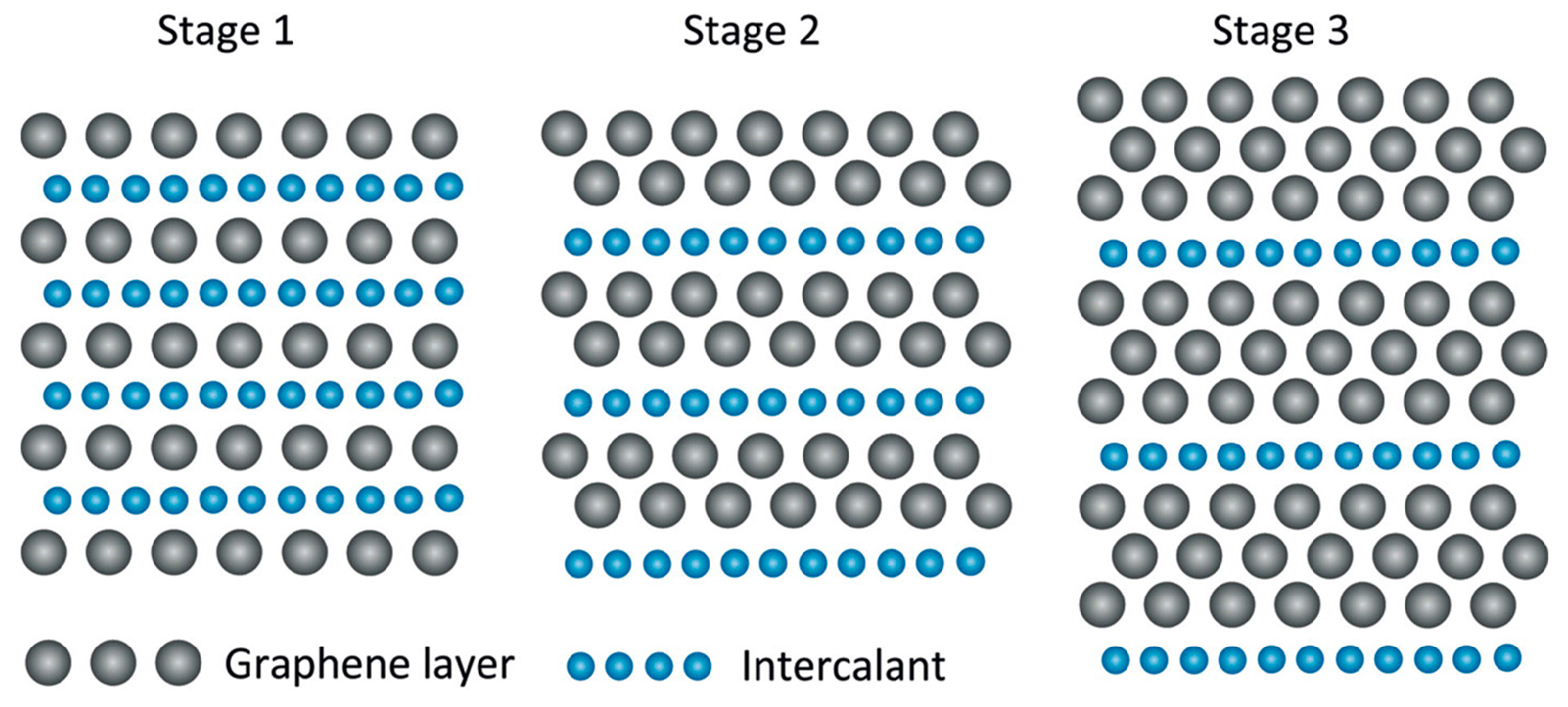
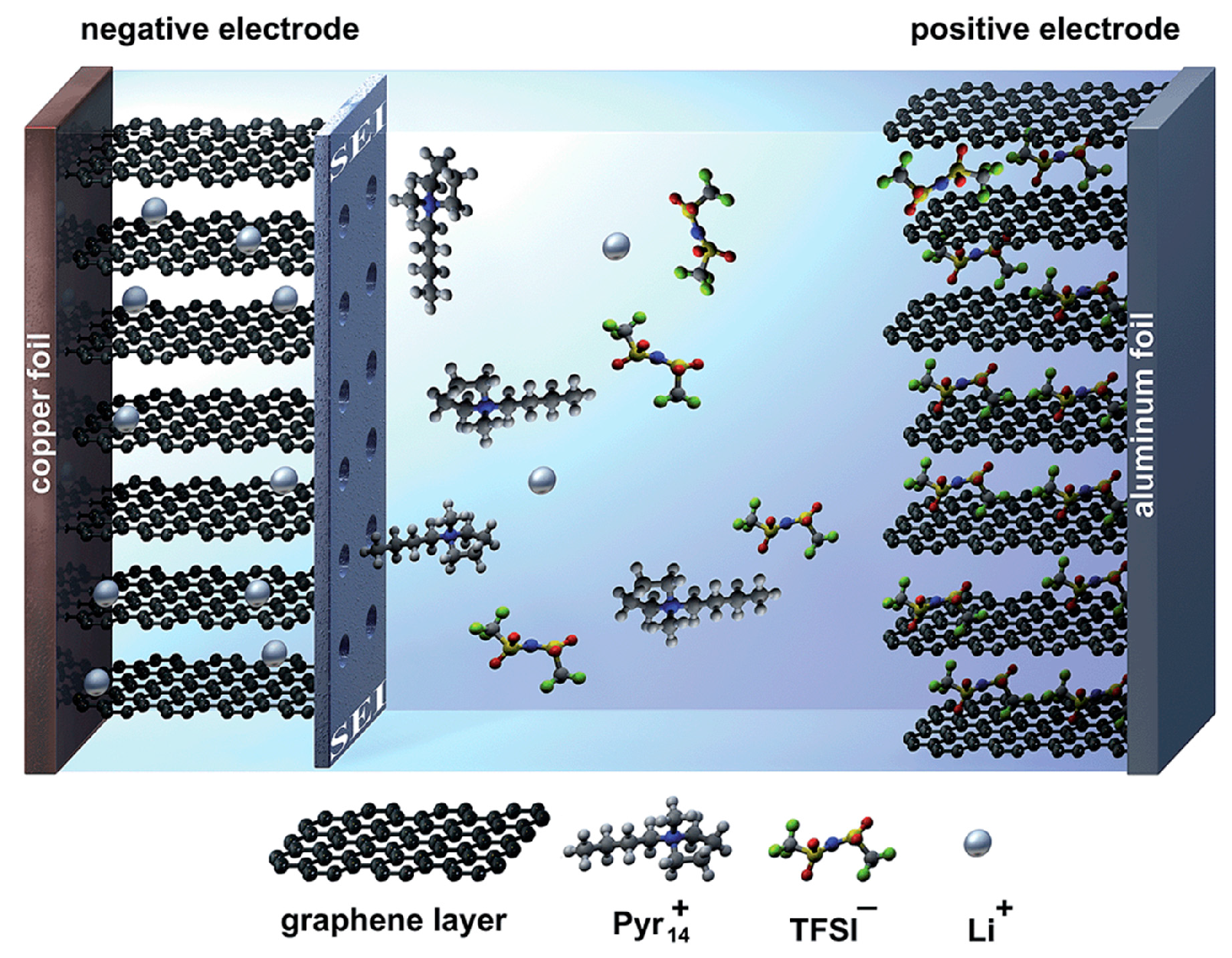
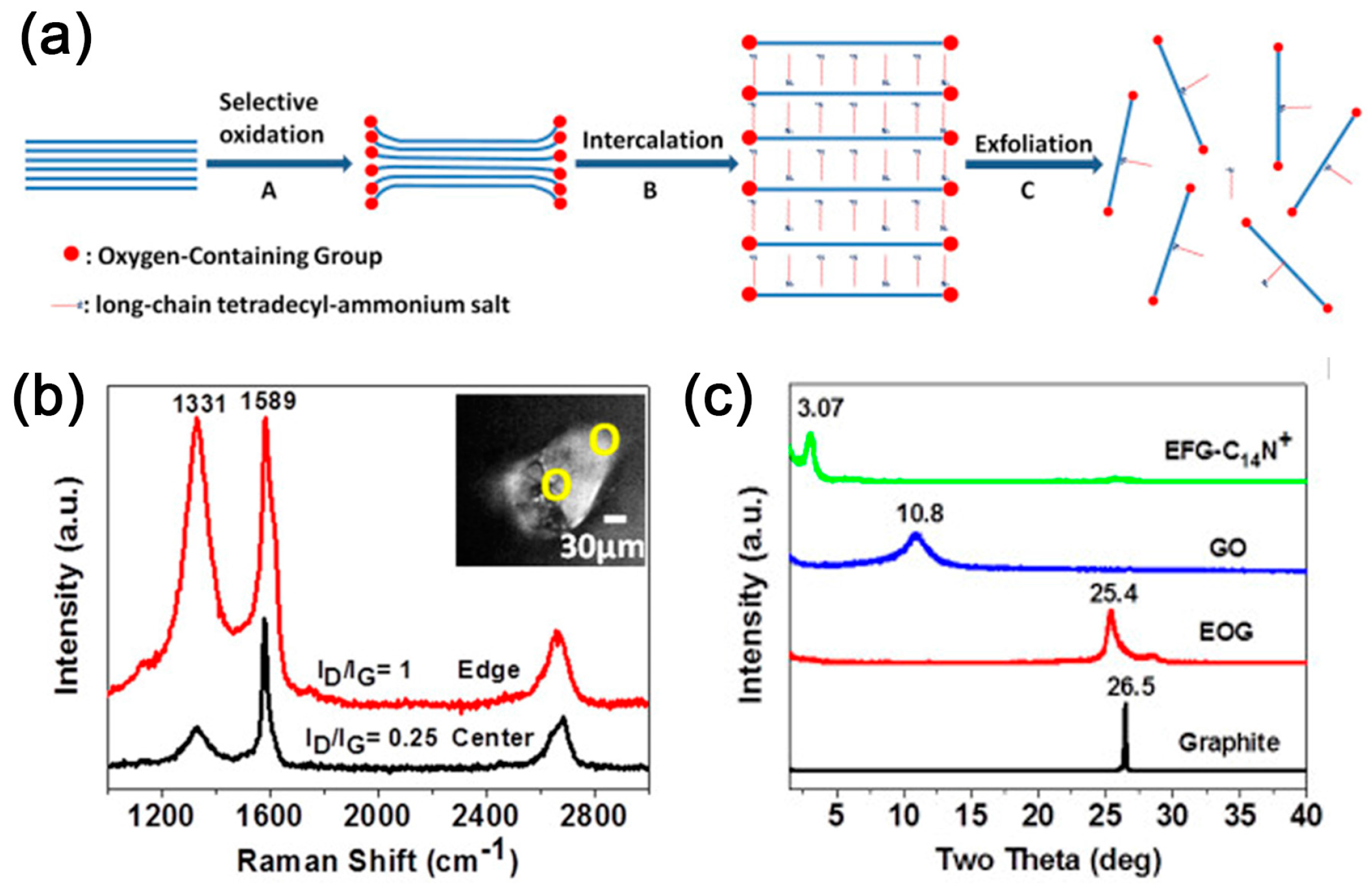
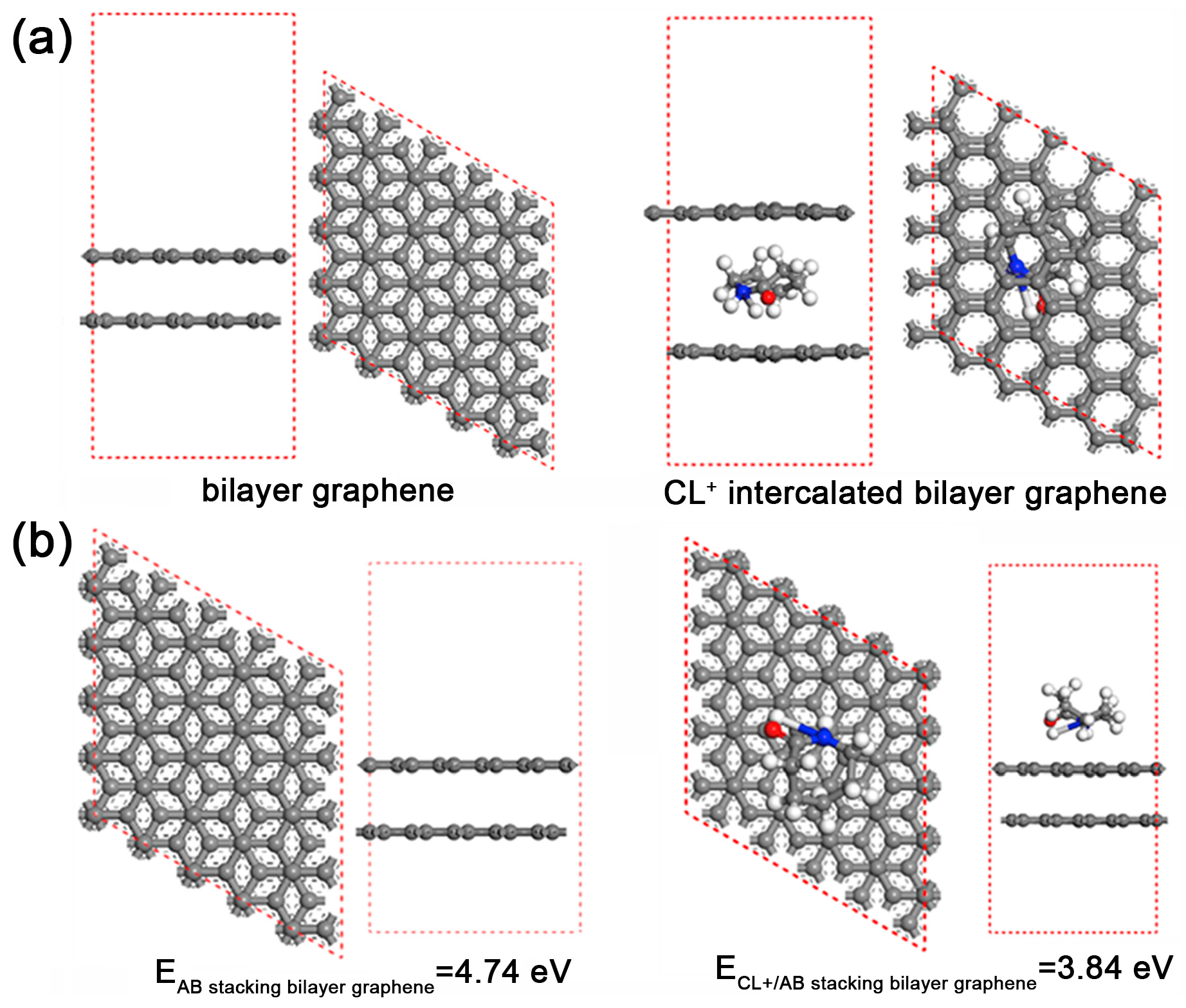
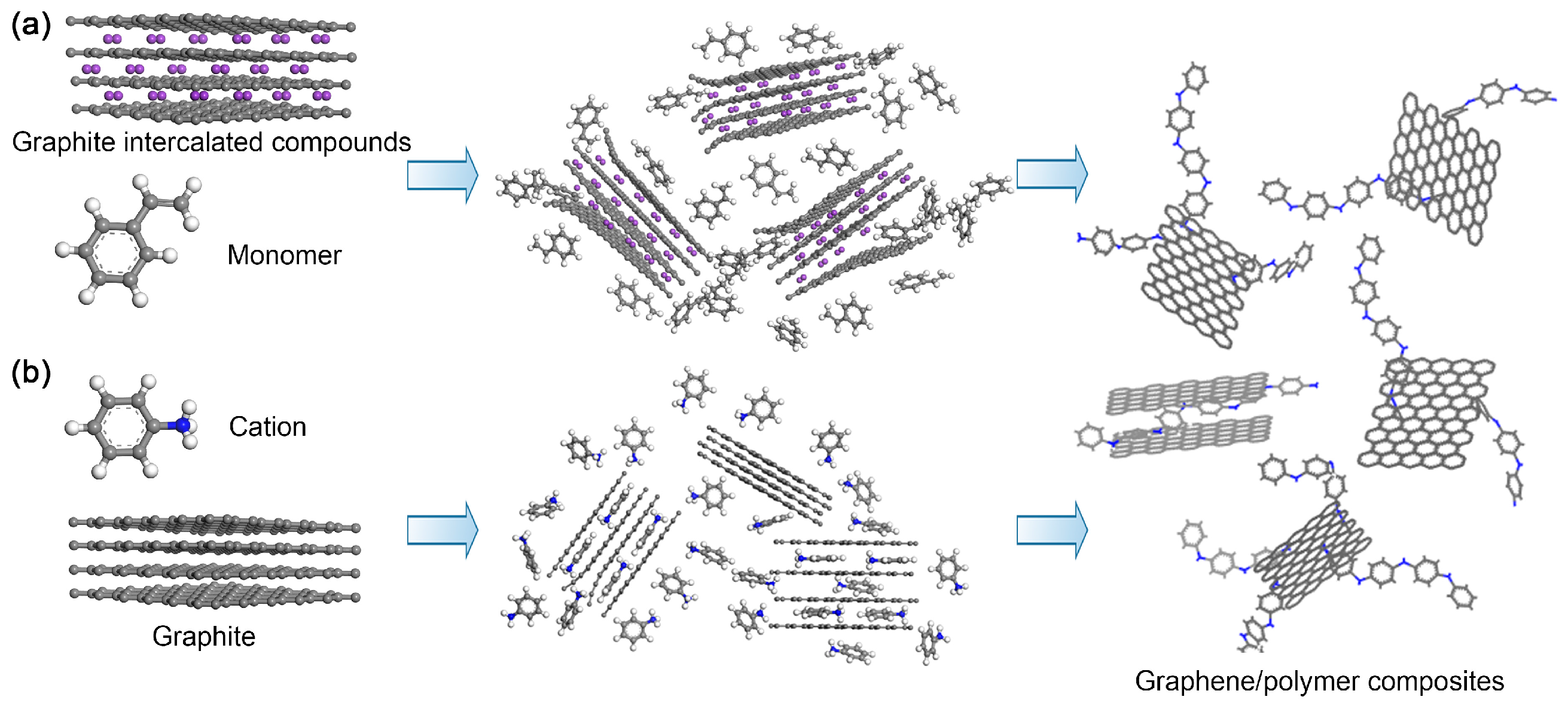
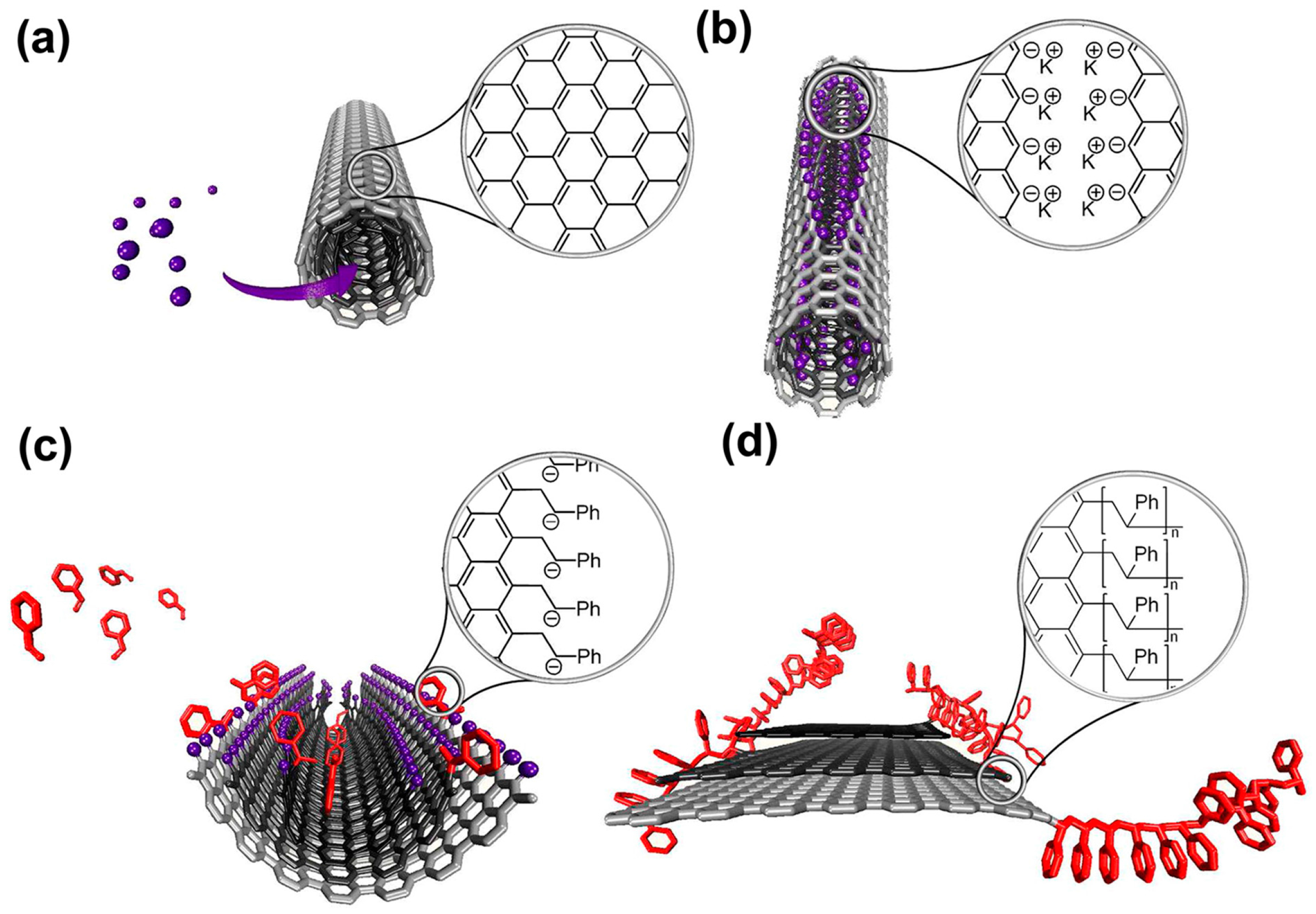
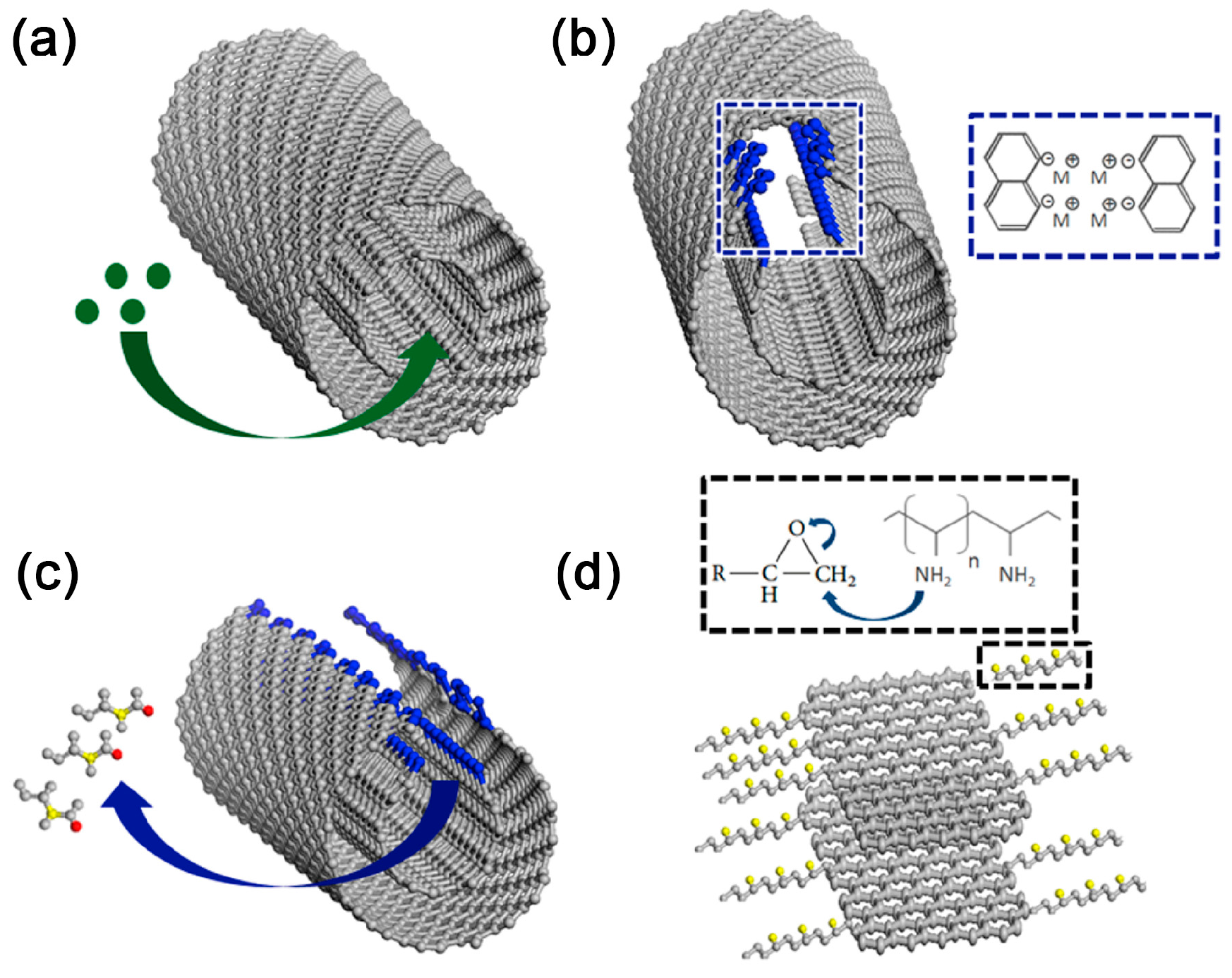
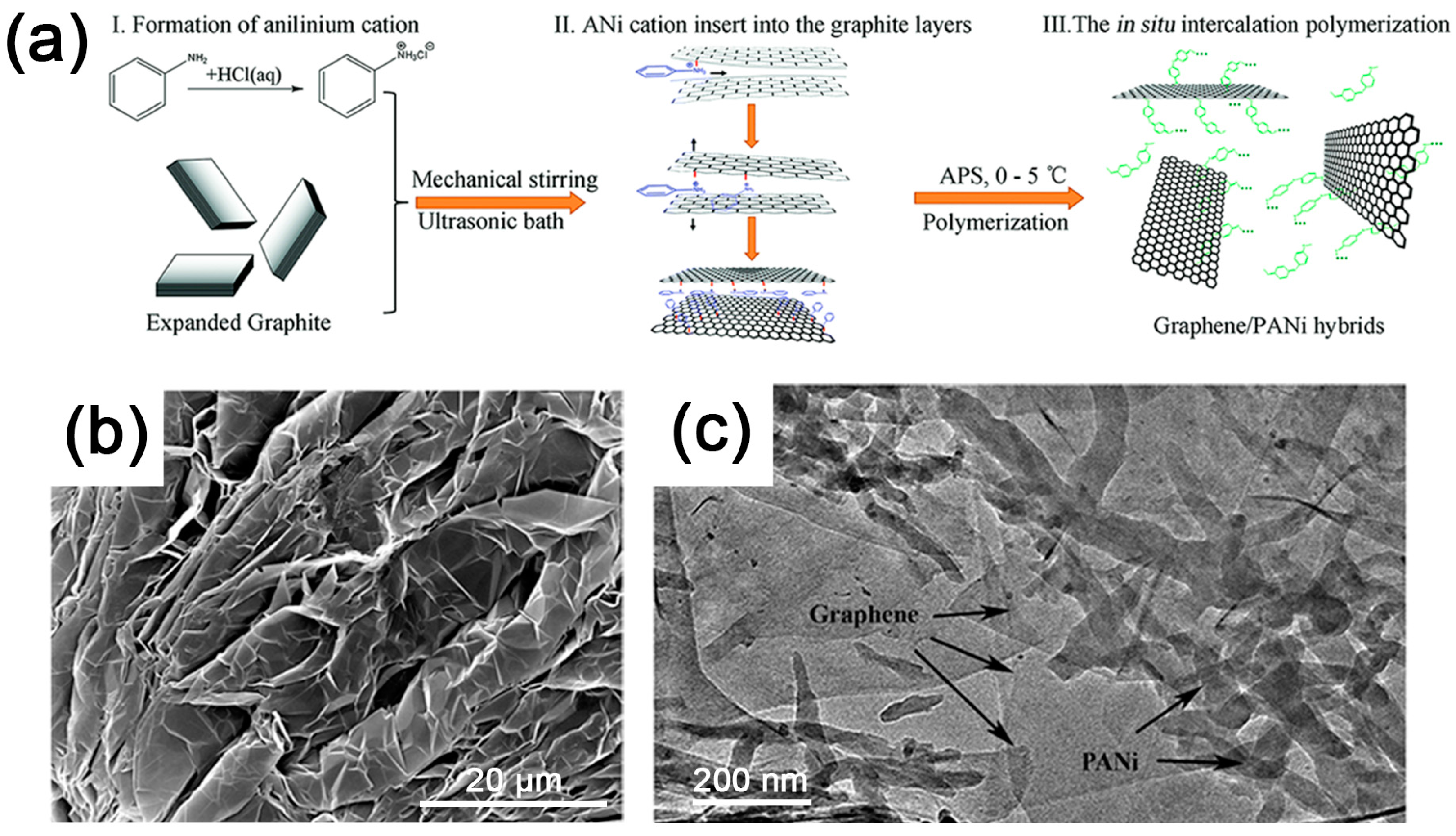
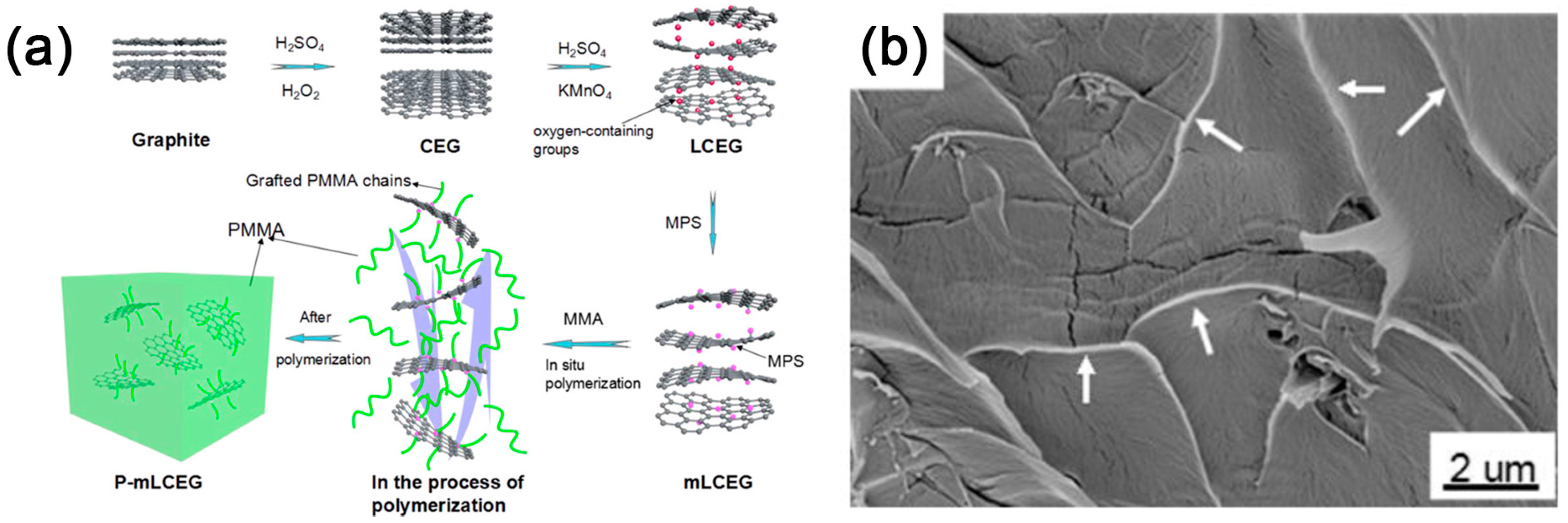
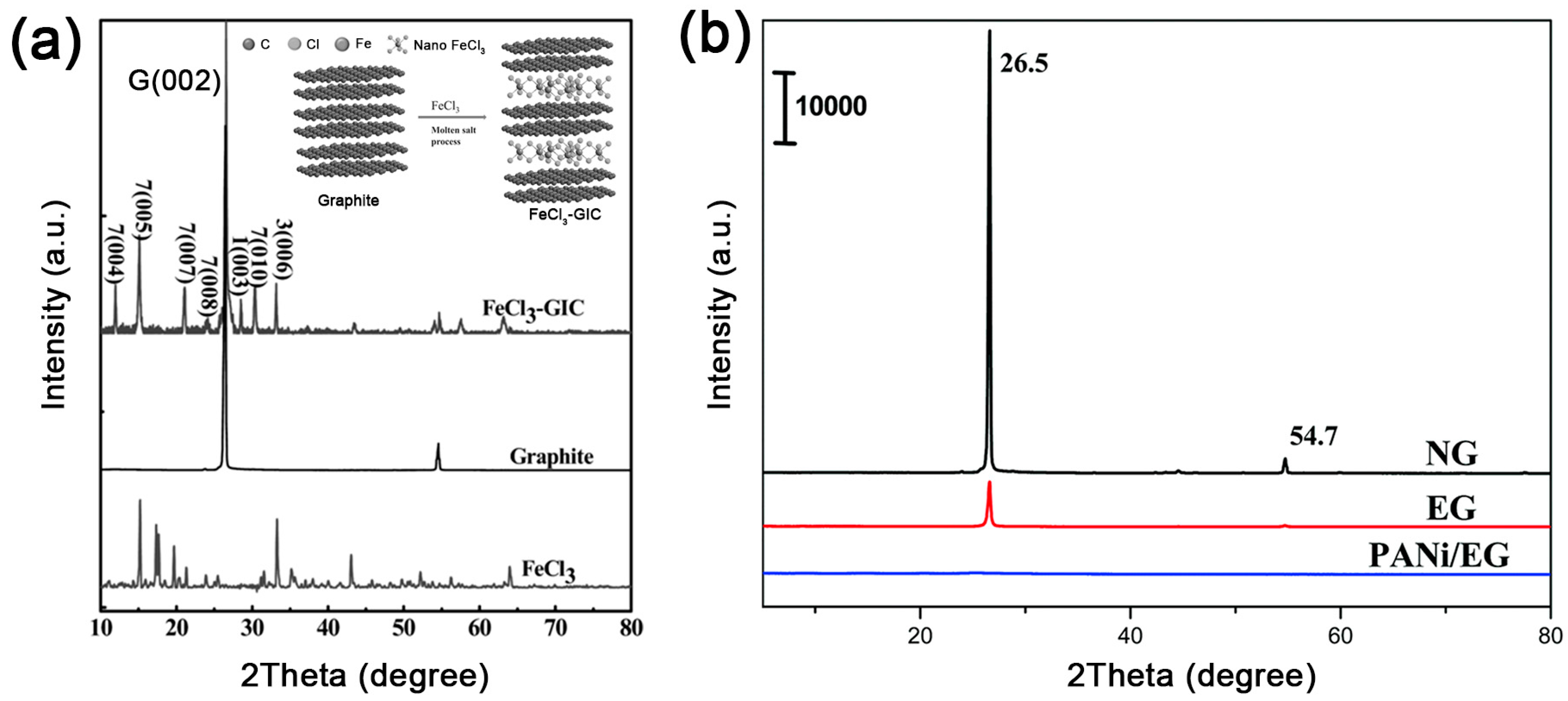
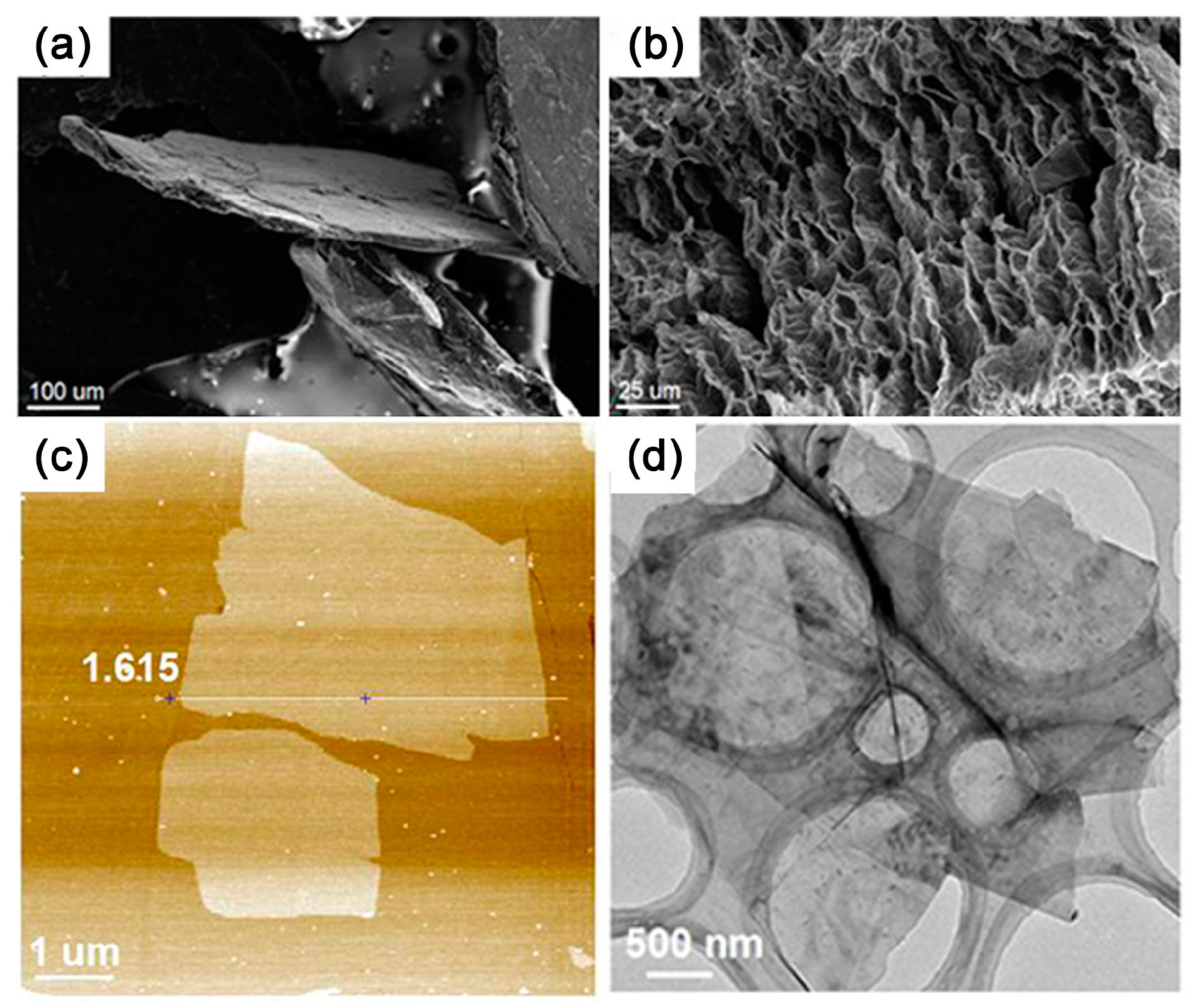
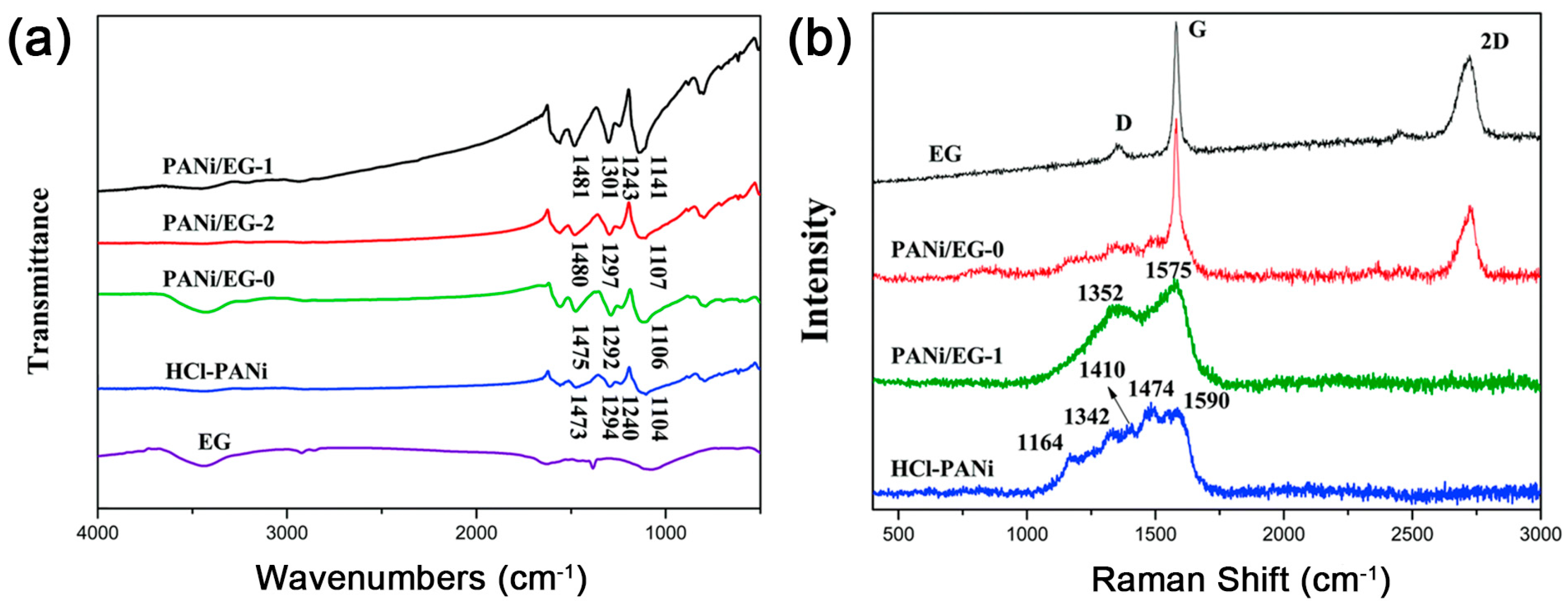




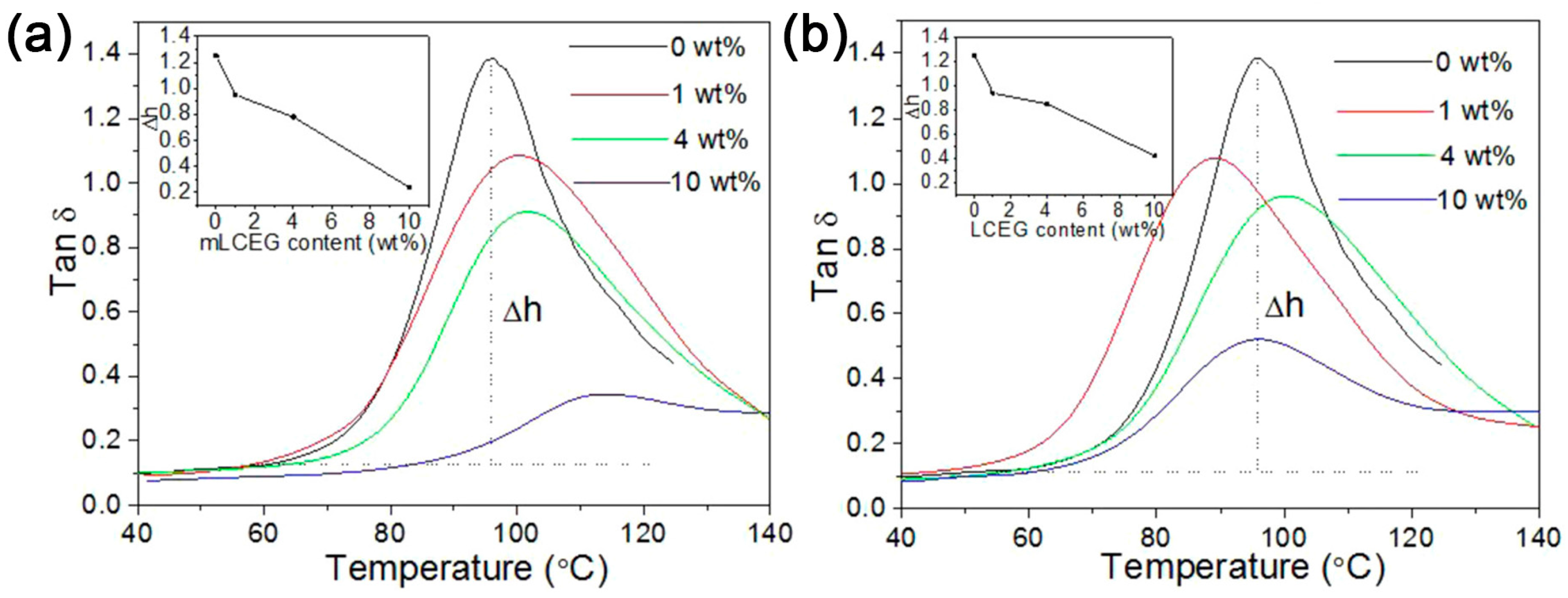
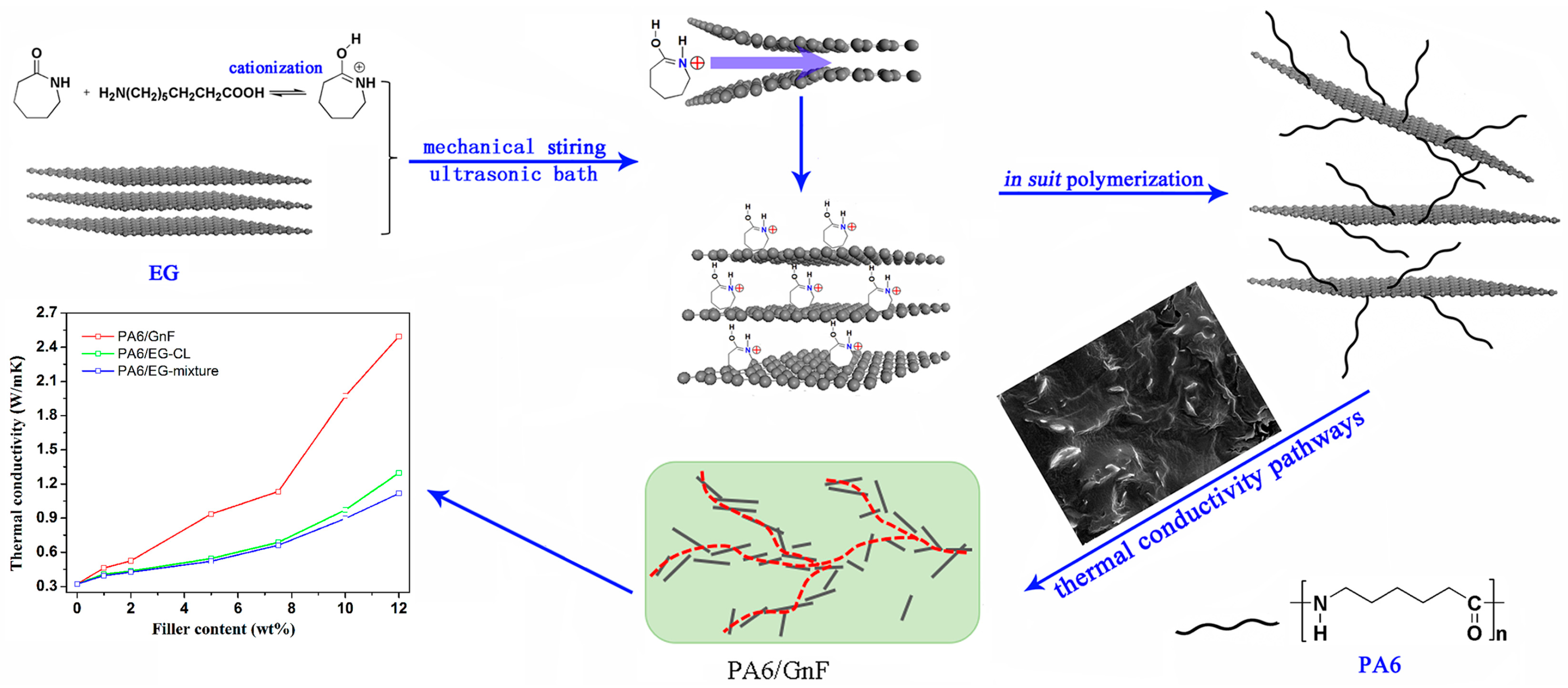

| Material | Synthesis method | Filler content | Electrical conductivity (S/m) | Reference |
|---|---|---|---|---|
| PMMA/Graphene | Intercalation polymerization | 4 wt % | 17.55 | [119] |
| 10 wt % | 1719 | |||
| PMMA/rGO | In situ polymerization | 3 wt % | 1.5 | [125] |
| PMMA/rGO | Aqueous mixing | 2 wt % | 3.7 × 10−2 | [126] |
| PEO/Graphene | Aqueous mixing | 2 wt % | 6 × 10−2 | [127] |
| PBT/rGO | Aqueous mixing | 10 wt % | 9 × 10−2 | [128] |
| PET/Graphene | Melt mixing | 7 wt % | ~10−4 | [129] |
| PI/rGO | In situ polymerization | 30 wt % | 11 | [130] |
| Epoxy/Graphene foam | Prepreg-hot press | 10 wt % | 230 | [131] |
| Absorber | Synthesis method | Matrix | Absorber content | Thickness (mm) | RL min (dB) | RL < −10 dB bandwidth (GHz) | Reference |
|---|---|---|---|---|---|---|---|
| PPy/GO | Intercalation polymerization | Wax | 30 wt % | 2.96 | −58.1 | 6.2 | [120] |
| PANi/Graphene | Intercalation polymerization | Wax | 10 wt % | 3.5 | −36.9 | 5.3 | [53] |
| PPy/Graphene | Intercalation polymerization | Wax | 10 wt % | 2.7 | −48.0 | 3.4 | [117] |
| PANi/Graphene | In situ polymerization | Wax | 25 wt % | 3.04 | −38.8 | 2.3 | [132] |
| PEO/rGO | Aqueous mixing | PEO | 2.6 vol % | 1.8 | −38.8 | 4.1 | [133] |
| NBR/GO | Aqueous mixing | NBR | 10 wt % | 3 | −57.0 | 4.5 | [134] |
| PANi/Graphene foam | In situ polymerization | Graphene foam | - | 2 | −52.5 | 3.0 | [135] |
| PANi/rGO | In situ polymerization | Wax | 50 wt % | 2 | −41.4 | 4.2 | [136] |
| Material | Synthesis method | Filler content | Mechanical properties relative to neat polymer (ΔE, ΔE’, Δσmax, ΔKIC) * | Reference |
|---|---|---|---|---|
| PMMA/Graphene | Intercalation polymerization | 10 wt % | ΔE’ = 299% (at 45 °C) | [119] |
| TPU/GNR | Intercalation polymerization | 0.5 wt % | ΔE = 70%, ΔE’ = 175% (at −25 °C), Δσmax = 15% | [115] |
| Epoxy/GNR | Intercalation polymerization | 0.15 wt % | ΔE = 11%, ΔKIC = 43% | [106] |
| PVA/GO | Intercalation polymerization | 0.04 wt % | ΔE = 43%, Δσmax = 20% | [107] |
| PMMA/rGO | In situ polymerization | 2 wt % | ΔE = 13%, Δσmax = −41% | [137] |
| PMMA/Graphene | Twin screw extruding | 20 wt % | ΔE = 7%, ΔE’ = 22% (at 100 °C), Δσmax = 3% | [138] |
| Epoxy/rGO | Ball mill | 2 wt % | ΔE = 5%, Δσmax = 0%, ΔKIC = 50% | [139] |
| Epoxy/Functioalized-GO | In situ polymerization | 0.5 wt % | ΔE = 16%, Δσmax = −75%, ΔKIC = 33% | [140] |
| Thermoplastic polyurethane (TPU)/Graphene | Aqueous mixing | 3 wt % | ΔE = 43%, Δσmax = −22% | [141] |
| Material | Synthesis method | Filler content | TC (W/(m·K)) | TC enhancement compared to neat polymer | Reference |
|---|---|---|---|---|---|
| PA-6/Graphite nanoflakes | Intercalation polymerization | 12 wt % | 2.49 | 678% | [18] |
| PA-6/rGO | In situ polymerization | 10 wt % | 0.416 | 112% | [143] |
| PA-6/Graphene foam | In situ polymerization | 2 wt % | 0.847 | 300% | [144] |
| PA-6/Graphene-GO | In situ polymerization | 10 wt % | 2.14 | 569% | [142] |
| PA-6/Graphite | Twin screw extruding | 30 wt % | 1.37 | 350% | [145] |
| PS/Graphite nanoflakes | Melt mixing | ~9.2 wt % | 0.9 | 398% | [146] |
| PP/Graphite nanoflakes | Aqueous mixing | 10 wt % | 1.53 | 595% | [147] |
| PVA/Graphite nanoflakes | Aqueous mixing | 10 wt % | 1.43 | 580% | [147] |
| PBT/Graphite nanoflakes | In situ polymerization | 20 wt % | 1.98 | 1320% | [148] |
| Application | Material | Description | Reference |
|---|---|---|---|
| Sensing of serotonin | PLA/GO | Electrochemical detection with high concentration range (0.1–100.0 µM) and low detection limit (0.08 µM, where s/n = 3) | [149] |
| Sensing of methanol | PANi/GO | High sensitivity (ΔR/R0 = 20.9–37) for methanol vapor (100–500 ppm) * | [150] |
| Electrochemical supercapacitor | PANi/GO | High specific capacitance of 543.75 F/g and reversible electrochemical response up to 150th repeated cycles | [151] |
| Water vapor barrier | PVA/GO | Water vapor permeability declines about 5-fold to 0.66 × 10−12 g·cm·(cm2·s·Pa)−1 by adding 0.04 wt % GO | [107] |
| Nitrogen gas barrier | TPU/GNR | Nitrogen gas effective diffusivity decreased by 3 orders of magnitude with only 0.5 wt % GNRs. | [115] |
© 2018 by the authors. Licensee MDPI, Basel, Switzerland. This article is an open access article distributed under the terms and conditions of the Creative Commons Attribution (CC BY) license (http://creativecommons.org/licenses/by/4.0/).
Share and Cite
Guo, Y.; Peng, F.; Wang, H.; Huang, F.; Meng, F.; Hui, D.; Zhou, Z. Intercalation Polymerization Approach for Preparing Graphene/Polymer Composites. Polymers 2018, 10, 61. https://doi.org/10.3390/polym10010061
Guo Y, Peng F, Wang H, Huang F, Meng F, Hui D, Zhou Z. Intercalation Polymerization Approach for Preparing Graphene/Polymer Composites. Polymers. 2018; 10(1):61. https://doi.org/10.3390/polym10010061
Chicago/Turabian StyleGuo, Yifan, Fuxi Peng, Huagao Wang, Fei Huang, Fanbin Meng, David Hui, and Zuowan Zhou. 2018. "Intercalation Polymerization Approach for Preparing Graphene/Polymer Composites" Polymers 10, no. 1: 61. https://doi.org/10.3390/polym10010061
APA StyleGuo, Y., Peng, F., Wang, H., Huang, F., Meng, F., Hui, D., & Zhou, Z. (2018). Intercalation Polymerization Approach for Preparing Graphene/Polymer Composites. Polymers, 10(1), 61. https://doi.org/10.3390/polym10010061








